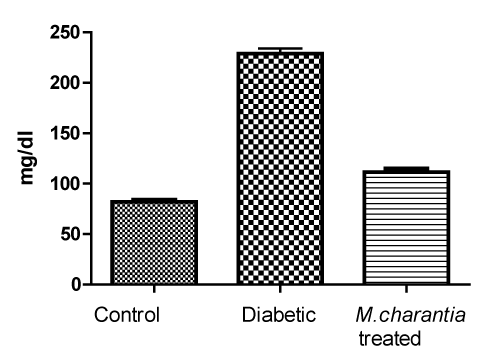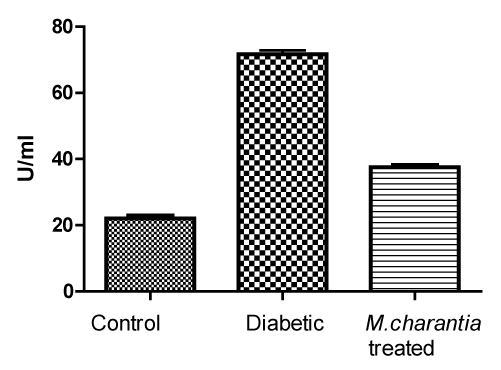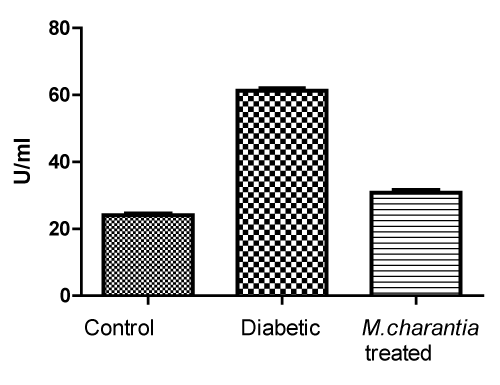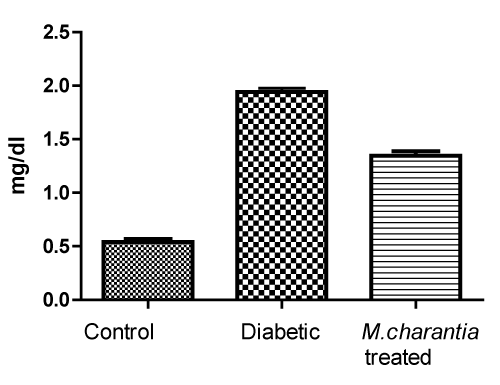| Research Article |
Open Access |
|
| Arun Kumar1*, Bhaskar Sharma2, Mohammad Ali1, Ranjit Kumar1, Nath A1 and Singh JK1 |
| 1Mahavir Cancer Sansthan and Research Centre, Phulwarisharif, Patna, Bihar, India |
| 2Department of Biochemistry, Allahabad Agricultural Institute Deemed University, Uttar Pradesh, India |
| *Corresponding author: |
Arun Kumar
Mahavir Cancer Sansthan and Research Centre
Phulwarisharif Patna
Bihar 801505, India
Tel: +91-933474080
E-mail: arunk31@rediffmail.com |
|
| Â |
| Received December 14, 2012; Published December 21, 2012 |
| Â |
| Citation: Kumar A, Sharma B, Ali M, Kumar R, Nath A, et al. (2013) Momordica charantia Protects the Liver from Hyperglycemia Induced Toxicity during Diabetes in Swiss Albino Mice. 2: 599 doi:10.4172/scientificreports.599 |
| Â |
| Copyright: © 2013 Kumar A, et al. This is an open-access article distributed under the terms of the Creative Commons Attribution License, which permits unrestricted use, distribution, and reproduction in any medium, provided the original author and source are credited. |
| Â |
| Abstract |
| Â |
| Diabetes mellitus is a universal problem affecting human societies at all stages of development. It is a condition where sufficient amount of insulin is either not produced or the body is unable to use the insulin that is produced, leading to excess glucose in the blood. The aim of this study was to investigate the anti- hyperglycemic activity of Momordica charantia fruit on alloxan induced diabetic mice and its antitoxic effect on liver. Mice were alloxanized (alloxan monohydrate 150 mg/kg body weight administered intraperitoneally) and aqueous extract of Momordica charantia at the rate of 100 mg/kg body weight was administered for 21 days to evaluate its anti- hyperglycemic activity. There serum glucose levels as well as the Liver Function Tests (LFT) - SGPT, SGOT and total bilirubin levels were analyzed statistically using ANOVA and Dunnett’s tests. Alloxan caused significant increase in the levels of serum glucose, SGPT, SGOT and bilirubin levels but after administration of Momordica charantia aqueous extract there was significant decrease in the serum glucose levels as well as SGPT, SGOT and total bilirubin levels. The study suggests that Momordica charantia possesses antidiabetic and antitoxic effects. |
| Â |
| Keywords |
| Â |
| Antidiabetic; Antitoxic; Momordica charantia; Alloxan |
| Â |
| Introduction |
| Â |
| Diabetes mellitus (DM) is a group of syndrome characterized by hyperglycemia and altered metabolism of carbohydrates, lipids and proteins. Chronic hyperglycemia during diabetes causes glycation of body proteins that in turn leads to secondary complications affecting eyes, kidneys, nerves and arteries [1]. Increasing evidences from both experimental and clinical studies suggest that oxidative stress plays a major role in the pathogenesis of DM. Free radicals are formed disproportionately in diabetes by glucose oxidation, nonenzymatic glycation of proteins and the subsequent oxidative degradation of glycated proteins [2]. Without insulin, the cells of the body cannot absorb sufficient glucose from the blood; hence blood glucose level increases, which is termed as hyperglycemia. If the glucose level in the blood remains high over a long period of time, this can result in long-term damage to organs, such as the kidneys, liver, eyes, nerves and heart [3]. |
| Â |
| Ayurvedic medicine is an ancient system of medicine that is native to Indian subcontinent. Many medicinal herbs are presently being used either as medicine or food supplant by millions of people in Indian subcontinent [4]. Momordica charantia (Cucurbitaceae) is a creping or climbing annual weak herb. It is extensively cultivated in India, China and other parts of south east. Medicinal properties of this fruits were studied for hypolipidemic and hepato-protective effects to animals also to be human subjects [5]. Since, no work has been reported on hepatoprotective effects of Momordica charantia during diabetes, the present work deals to observe the antidiabetic and antitoxic effects of Momordica charantia. |
| Â |
| Materials and Methods |
| Â |
| Animals |
| Â |
| Twenty four female Swiss albino mice (28 g to 32 g) and 8 weeks old were obtained from animal house of Mahavir Cancer Institute and Research Centre, Patna, India (CPCSEA Regd. No. 1129/bc/07/CPCSEA, dated 13/02/2008). The research work was approved by the IAEC (Institutional Animal Ethics Committee) with no. IAEC/2011/12/01. Food and water to mice were provided ad libitum (prepared mixed formulated feed by the laboratory itself). Animals were maintained in colony rooms with 12 h light/dark cycle at 22 ± 2°C. |
| Â |
| Chemicals |
| Â |
| Alloxan was purchased from the Loba chemie, Mumbai. Commercially available kit from Crest Coral Clinical System, Goa, India was used for the measurement of glucose, Serum Glutamate Pyruvate Transaminase (SGPT), Serum Glutamate Oxalate Transaminase (SGOT) and bilirubin. |
| Â |
| Plant material |
| Â |
| The fresh fruit of Momordica charantia (Local name-Karela) were procured from local market (Patna). The identity of the fruit of M. charantia was confirmed by Dr. Ramakant Pandey (Botanist), Department of Biochemistry, Patna University, Patna, Bihar, India. The fruit were washed with distilled water and dried completely under the mild sun and crushed with electrical grinder coarse powder. Aqueous extract was made by dissolving it in distilled water using by mortal and pistal. The dose was finally made to 100 mg/kg body weight for oral administration after the LD50 estimation. |
| Â |
| Experimental design |
| Â |
| In the present study 18 mice were taken and divided into three groups – control (n=6), alloxan treated (n=12). The alloxan (alloxan monohydrate) at the rate of 150 mg/kg body weight were administered intraperitoneal (i.p) for making the alloxan induced diabetic mice model. Alloxan was administered on 7th and 14th day to make the perfect diabetic model. To this alloxan treated group (n=6) M. charantia at the rate of 100 mg/kg body weight per day was administered for 21 days through Gavage method. During the experimental period, the glucose levels were monitored in diabetic group as well as in M. charantia treated group regularly. After the completion of the experiment the animals were anaesthetized and their blood samples were collected by orbital sinus puncture method and then serum were extracted. |
| Â |
| Statistical analysis |
| Â |
| Results are presented as mean ± S.D and total variation present in a set of data was analysed through one-way analysis of variance (ANOVA). Difference among means has been analysed by applying Dunnet’s t test at 99.9% (p<0.001) confidence level. Calculations were performed with the GraphPad Prism Program (GraphPad Software, Inc., San Diego, USA). |
| Â |
| Results |
| Â |
| The serum glucose levels shows inclination in the levels in the alloxan induced diabetic group in comparison to control group while the M. charantia shows the glucose lowering down activity denotes the antidiabetic effect. The liver function test shows elevation in the levels of SGPT, SGOT and bilirubin levels in alloxan induced groups while the M. charantia shows declination in the LFT levels denotes the antitoxic effects (Figures 1-4). |
| Â |
|
|
Figure 1: Effect of M. charantia on Diabetic induced group showing Glucose levels (n=6, values are mean ± S.D). |
|
| Â |
|
|
Figure 2: Effect of M. charantia on Diabetic induced group showing SGPT activity (n=6, values are mean ± S.D). |
|
| Â |
|
|
Figure 3: Effect of M. charantia on Diabetic induced group showing SGOT activity (n=6, values are mean ± S.D). |
|
| Â |
|
|
Figure 4: Effect of M. charantia on Diabetic induced group showing Bilirubin level (n=6, values are mean ± S.D). |
|
| Â |
| Discussion |
| Â |
| Diabetes mellitus is one of the most common chronic diseases associated with carbohydrate metabolism. It is also an indication of co-morbidities such as obesity, hypertension, and hyperlipidemia which are metabolic complications of both clinical and experimental diabetes. Alloxan, a beta cytotoxin induces chemical diabetes (Alloxan diabetes) in a wide variety of animal species by damaging the insulin secreting pancreatic β-cell, resulting in a decrease in endogenous insulin release, which paves way for the decreased utilization of glucose by the tissues [6-8]. In the present study the alloxan induced group resulted in the steady increase in the serum glucose level during experimental period, indicating hyperglycemia as similar observations were also observed in a variety of species [9,10]. |
| Â |
| The liver is one of the tissues that bear the brunch of chronically hyperglycemia since glucose is freely permeable to its cells [11]. This unrestrained entry in the presence of excess and sustained glucose in blood is bound to cause metabolic derangement which would express themselves on the gross architecture of the tissues. Diabetes mellitus is one of the commonest causes of liver failure and hepatomegaly reported by Chatila and West [12]. SGPT and SGOT assay are important in the diagnosis of liver damage caused by drug toxicity or harmful chemical [13]. In the present study in the animals treated with alloxan developed hepatic damage which was evident from the increase in the enzyme activities as the levels of SGPT, SGOT and bilirubin significantly increased which denotes the level of the toxicity. These are active only in the absence of insulin because it increases the availability of amino acid in diabetes which is responsible for ketogenesis and gluconeogenesis [14]. In a study on rats, the significant rise in serum SGPT and SGOT levels in diabetic group relates to excessive accumulation of amino acids (glutamate and alanine) in the serum of diabetic animals as a result of amino acids mobilization from protein stores. The higher levels of SGPT and SGOT, may give rise to a high concentration of glucose. In other words, the gluconeogenic action of SGPT and SGOT plays the role of providing new supplies of glucose from other sources such as amino acids [15-20]. |
| Â |
| On the other hand, treatment of the diabetic mice with M. charantia for 21 days showed antidiabetic effect as the serum glucose levels reached their normal levels, while on the hand it is also capable in controlling the SGPT, SGOT and bilirubin levels denotes the antitoxic effects. Similar effects through various other medicinal plants have been well observed [21-24]. |
| Â |
| Thus, from the entire study it can be concluded that M. charantia can be used as potent natural anti-diabetic drug which can control the diabetes at much level. Furthermore it also protects the liver from the diabetic damage and restores of cellular status of the liver. |
| Â |
| Acknowledgement |
| Â |
| The authors are thankful to Mahavir Cancer Institute and Research Centre, Phulwarisharif, Patna for providing the necessary laboratory and library facilities. |
| Â |
| |
| References |
| Â |
- Sharma AK (1993) Diabetes mellitus and its complications: An update (1st edn), Macmillan India Ltd, New Delhi, India.
- Maritim AC, Sanders RA, Watkins JB 3rd (2003) Diabetes, oxidative stress, and antioxidants: a review. J Biochem Mol Toxicol 17: 24-38.
- Ranasinghe P, Perera S, Gunatilake M, Abeywardene E, Gunapala N, et al. (2012) Effects of Cinnamomum zeylanicum (Ceylon cinnamon) on blood glucose and lipids in a diabetic and healthy rat model. Pharmacognosy Res 4: 73-79.
- Cooper EL (2008) Ayurveda and eCAM: A Closer Connection. Evid Based Complement Alternat Med 5: 121-122.
- Singh J, Cumming E, Manoharan G, Kalasz H, Adeghate E (2011) Medicinal chemistry of the anti-diabetic effects of momordica charantia: active constituents and modes of actions. Open Med Chem J 5: 70-77.
- Baynes JW (1991) Role of oxidative stress in development of complications in diabetes. Diabetes 40: 405-412.
- Rerup CC (1970) Drugs producing diabetes through damage of the insulin secreting cells. Pharmacol Rev 22: 485-518.
- Nakabow Y, Kashnu T, Takana Y, Hgihira H (1978) Action of alloxan on beta cells. J Nutri Sci Vitaminol 24: 205-208.
- Nagappa AN, Thakurdesai PA, Venkat Rao N, Singh J (2003) Antidiabetic activity of Terminalia catappa Linn fruits. J Ethnopharmacol 88: 45-50.
- al-Hader AA, Hasan ZA, Aqel MB (1994) Hyperglycemic and insulin release inhibitory effects of Rosmarinus officinalis. J Ethnopharmacol 43: 217-221.
- Mayes PA (2000) Gluconeogenesis and control of the blood glucose. In: Murray RK, Granner DK, Mayes PA, Rodwell VW eds. HarperÂ’s Biochemistry (25thedn), New York: McGraw-Hill: 20-218.
- Chatila R, West AB (1996) Hepatomegaly and abnormal liver tests due to glycogenosis in adults with diabetes. Medicine (Baltimore) 75: 327-333.
- Agarwal V, Sharma AK, Upadhyay A, Singh G, Gupta R (2012) Hypoglycemic effects of Citrullus colocynthis roots. Acta Pol Pharm 69: 75-79.
- Chalasani N, Aljadhey H, Kesterson J, Murray MD, Hall SD (2004) Patients with elevated liver enzymes are not at higher risk for statin hepatotoxicity. Gastroenterology 126: 1287-1292.
- Colev V, Badescu M, Paduraru I, Mândreci I, Bohotin C (1994) The zinc-metabolic disorder relation in experimental diabetes mellitus. Rom J Intern Med 32: 71-75.
- Rana SV, Singh R, Verma S (1996) Protective effects of few antioxidants on liver function in rats treated with cadmium and mercury. Indian J Exp Biol 34: 177-179.
- El-Demerdash FM, Yousef MI, El-Naga NI (2005) Biochemical study on the hypoglycemic effects of onion and garlic in alloxan-induced diabetic rats. Food Chem Toxicol 43: 57-63.
- Hussein HM, EI-Sayed EM, Said AA (2006) Antihyperglycemic, Antihyperlipidemic and Antioxidant Effects of Zizyphus spina christi and Zizyphus jujuba in Alloxan Diabetic Rats. International Journal of Pharmacology 2: 563-570.
- Badole S, Patel N, Bodhankar S, Jain B, Bhardwaj S (2006) Antihyperglycemic activity of aqueous extract of leaves of Cocculus hirsutus (L.) Diels in alloxan-induced diabetic mice. Ind J Pharmacol 38: 49-53.
- Badole SL, Shah SN, Patel NN, Thakurdesai PA, Bodhankar SL (2006) Hypoglycemic activity of aqueous extract of Pleurotus pulmonarius. Quel.-Champ in alloxan induced diabetic mice. Pharmaceutical Biology 44: 421-425.
- Chaturvedi P (2012) Antidiabetic potentials of Momordica charantia: multiple mechanisms behind the effects. J Med Food 15: 101-107.
- Chattopadhyay RR. Bandyopadhyay M (2005) Possible mechanism of hepatoprotective activity of Azadirachta indica leaf extract against paracetamol- induced hepatic damage in rats: Part III. Ind J Pharm 37: 184-185.
- Blum A, Loerz C, Martin HJ, Staab-Weijnitz CA, Maser E (2012) Momordica charantia extract, a herbal remedy for type 2 diabetes, contains a specific 11ß-hydroxysteroid dehydrogenase type 1 inhibitor. J Steroid Biochem Mol Biol 128: 51-55.
- Virdi J, Sivakami S, Shahani S, Suthar AC, Banavalikar MM, et al. (2003) Antihyperglycemic effects of three extracts from Momordica charantia. J Ethnopharmacol 88: 107-111.
|
| Â |
| Â |




